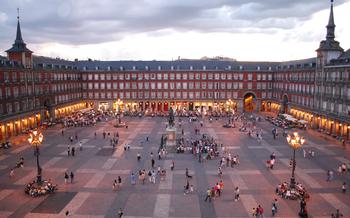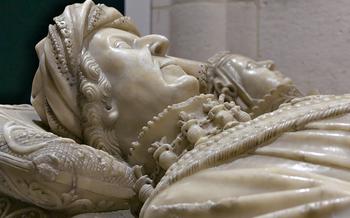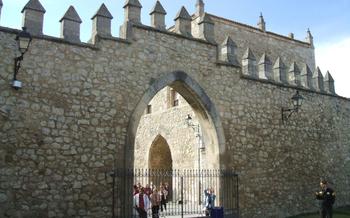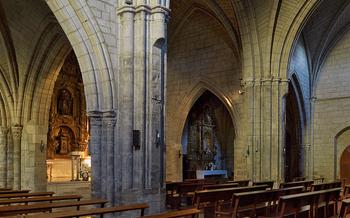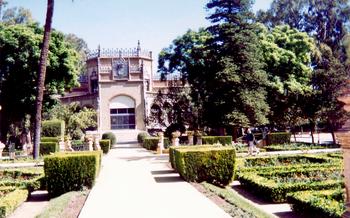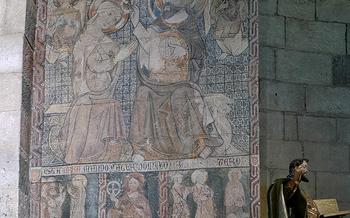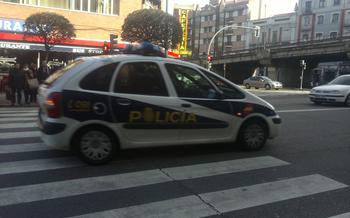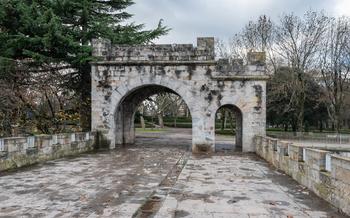
Cueva de San Adrián
- Historical Significance
- Guided Tours
- Accessibility
- Nearby Attractions
- Photography Tips
- Things to Bring
- Safety Precautions
- Family-Friendly Activities
- Accessibility for Visitors with Disabilities
- Insider Tip:
Historical Significance
The Cueva de San Adrián holds a significant place in Spanish history, dating back to ancient times. The cave was first discovered in the 1960s by local farmers who stumbled upon its hidden entrance while working on their land. Further exploration revealed a wealth of archaeological treasures, including prehistoric paintings and engravings, stone tools, and human remains. These findings suggest that the cave was inhabited by humans as early as 25,000 years ago, making it one of the most important Paleolithic sites in the region. The combination of its historical significance and well-preserved cave art has earned the Cueva de San Adrián the status of a Spanish National Monument.
Guided Tours
To make the most of your visit to the Cueva de San Adrián, it is highly recommended to join a guided tour. Guided tours are led by experienced and knowledgeable guides who will provide insightful commentary on the cave's history, geology, paleolithic art, and local legends. They will also point out the most significant features of the cave and answer any questions you may have.
Tours are available in multiple languages, including English, Spanish, and French. They typically last for about an hour and cover the most important areas of the cave. It is advisable to book your tour in advance, especially during peak season, to avoid disappointment. You can book online or through the local tourist office.
During the tour, you will be provided with a flashlight or headlamp to help you navigate the darker sections of the cave. It is important to follow the instructions of your guide and stay on the designated paths to avoid disturbing the fragile cave environment.
Guided tours are a must for anyone who wants to fully appreciate the significance and beauty of the Cueva de San Adrián. They offer a unique opportunity to learn about the cave's rich history and cultural heritage, and to see the stunning cave paintings and formations up close.
Accessibility
The Cueva de San Adrián is located in the province of Burgos, in the autonomous community of Castile and León, Spain. It is situated near the town of San Adrián de Juarros, about 10 kilometers (2 miles) from the provincial capital, Burgos. To reach the cave, visitors can take the N-623 road from Burgos and follow the signs to San Adrián de Juarros. From there, the cave is accessible by a local road.
The cave is open to the public and guided tours are available. Visitors should be aware that the cave is not accessible for visitors with disabilities as there are several steep and narrow passages that require climbing. However, there is a visitor center with accessible exhibits and information about the cave that visitors with disabilities can enjoy.
Parking facilities are available near the visitor center, and there is a designated area for buses. Visitors are advised to wear comfortable shoes and clothing, as the cave floor can be uneven and slippery.
Nearby Attractions
The Cueva de San Adrián is nestled in the heart of the enchanting region of Burgos, renowned for its rich historical and cultural heritage. A visit to the cave can be effortlessly combined with other captivating attractions in the vicinity, offering a comprehensive and enriching experience for travelers.
For history enthusiasts, the city of Burgos, a mere 40 kilometers away, beckons with its awe-inspiring Gothic architecture, epitomized by the majestic Burgos Cathedral, a UNESCO World Heritage Site. The city also boasts the Museo de Burgos, which houses a remarkable collection of archaeological artifacts, including some fascinating pieces unearthed from the Cueva de San Adrián.
Nature lovers will find solace in the stunning landscapes of the Sierra de la Demanda, a mountain range that offers breathtaking views and a plethora of outdoor activities, including hiking, mountain biking, and rock climbing. The region is also home to the Parque Natural de las Hoces del Alto Ebro y Rudrón, a natural park renowned for its picturesque gorges, lush forests, and diverse wildlife.
For those seeking a spiritual experience, the Monastery of San Pedro de Arlanza, located just 20 kilometers from the cave, offers a glimpse into the region's monastic past. Founded in the 10th century, this Benedictine monastery exudes an aura of tranquility and spirituality, inviting visitors to connect with their inner selves amidst its serene surroundings.
Whether you're passionate about history, nature, or spirituality, the region surrounding the Cueva de San Adrián offers an abundance of attractions to satisfy your curiosity and create lasting memories.
Photography Tips
Capturing the essence and beauty of the Cueva de San Adrián through photography requires careful consideration of lighting, composition, and camera settings. To achieve stunning shots, it's advisable to use a tripod to stabilize your camera and avoid blurry images. Experiment with different shutter speeds to capture the movement of water droplets or create a sense of motion in your photographs. For optimal results, visit the cave during the golden hours of sunrise or sunset when natural light beautifully illuminates the cave's formations. Remember to adjust your camera's white balance to accurately represent the cave's unique lighting conditions.
Things to Bring
When embarking on your journey to the Cueva de San Adrián, it is essential to ensure you are well-equipped to make the most of your experience. Here's a list of essential items you should consider packing:
-
Comfortable Footwear: Good hiking shoes or sturdy sneakers with good traction are a must for navigating the cave's uneven terrain and slippery surfaces.
-
Appropriate Clothing: Dress in layers as the temperature inside the cave can be cool and humid. A light jacket or sweater is recommended, along with comfortable pants that allow for easy movement.
-
Camera and Flashlight: Bring a camera to capture the stunning cave formations and artwork. A flashlight is also essential for exploring the darker corners of the cave.
-
Snacks and Water: Pack some light snacks and water to keep yourself energized during your visit. The cave does not have any food or beverage services, so it's best to come prepared.
-
First-Aid Kit: It's always a good idea to carry a small first-aid kit in case of minor injuries or emergencies.
-
Binoculars: If you're interested in birdwatching or observing the cave's wildlife, a pair of binoculars can enhance your experience.
-
Sunscreen and Hat: If you plan to explore the surrounding area, don't forget to pack sunscreen and a hat to protect yourself from the sun.
-
Cash or Credit Card: While most attractions accept credit cards, it's always a good idea to have some cash on hand for small purchases or tips.
-
Guidebook or Map: If you prefer self-guided exploration, consider bringing a guidebook or map of the cave to help you navigate and learn more about its features.
Safety Precautions
Exploring the Cueva de San Adrián requires adherence to safety guidelines to ensure a secure and enjoyable visit. Visitors should be mindful of the following:
-
Uneven Surfaces: The cave floor can be uneven and slippery due to moisture. Sturdy, closed-toe shoes with good traction are essential to prevent slips and falls.
-
Low Ceilings: Some sections of the cave have low ceilings, requiring visitors to duck or stoop to avoid bumping their heads. Pay attention to the height restrictions and follow the designated paths.
-
Darkness: The cave is naturally dark, and artificial lighting is limited to preserve the integrity of the cave art. Visitors are advised to bring a flashlight or headlamp to navigate safely through the dimly lit passages.
-
Confined Spaces: The cave's narrow passages and chambers can feel confining, especially for those prone to claustrophobia. If you experience discomfort in enclosed spaces, consider taking frequent breaks or exploring the cave in the company of others.
-
Emergency Preparedness: Familiarize yourself with the emergency exits and procedures before entering the cave. In case of an emergency, remain calm and follow the instructions provided by the guides or staff members.
Family-Friendly Activities
Visiting the Cueva de San Adrián can be a memorable and educativa experience for families with children. The cave offers a unique opportunity to explore the wonders of the natural world and learn about ancient history. To make the most of your family visit, here are some tips and suggestions:
-
Choose a Family-Friendly Tour: Opt for a guided tour specifically designed for families, as these tours are tailored to engage and educate children. Guides will explain the cave's features in a way that is both interesting and understandable for kids.
-
Prepare Your Children: Before visiting the cave, talk to your children about what they can expect to see and experience. Explain that the cave is dark and cool, and that they may need to wear helmets for safety.
-
Engage in Hands-On Activities: The cave offers interactive exhibits and workshops that allow children to learn about archaeology and cave art. These activities can make the visit more engaging and memorable for kids.
-
Take Breaks: The cave tour can be physically demanding, especially for younger children. Take breaks along the way to rest and give your children a chance to explore the surroundings.
-
Make it Fun: Encourage your children to use their imagination as they explore the cave. Ask them to imagine what it was like for prehistoric people to live in the cave and create their art.
Accessibility for Visitors with Disabilities
The Cueva de San Adrián is committed to providing an accessible and inclusive experience for visitors with disabilities. Wheelchair users and visitors with limited mobility can enjoy the cave's wonders thanks to several accessibility features.
The cave's main entrance is wheelchair accessible, and a designated accessible route allows visitors to explore the cave's highlights. The route is well-lit and has handrails for added support. Visitors can also request a wheelchair upon arrival if needed.
Trained staff members are available to assist visitors with disabilities throughout their visit. They can provide information, guidance, and assistance with any specific needs. Visitors can also request a sign language interpreter or other accommodations in advance to ensure a smooth and enjoyable experience.
The Cueva de San Adrián also offers special programs and events designed for visitors with disabilities. These programs may include guided tours with adapted content, sensory experiences, or workshops that focus on the cave's history and art in an accessible way.
By providing these accessibility features and services, the Cueva de San Adrián strives to create an inclusive environment where everyone can explore and appreciate the cave's wonders, regardless of their abilities.
Insider Tip:
For a truly memorable experience, visit the Cueva de San Adrián during the off-season, typically from November to March. During this time, you'll encounter fewer crowds, allowing you to fully immerse yourself in the cave's tranquility and appreciate its natural beauty without distractions. Moreover, the cooler temperatures provide a more comfortable environment for exploring the cave's depths. Additionally, keep an eye out for the hidden chamber known as the "Sala de los Secretos." This secluded chamber, accessible through a narrow passage, boasts a stunning display of stalactites and stalagmites that resemble a celestial canopy. It's a hidden gem that's not to be missed!

